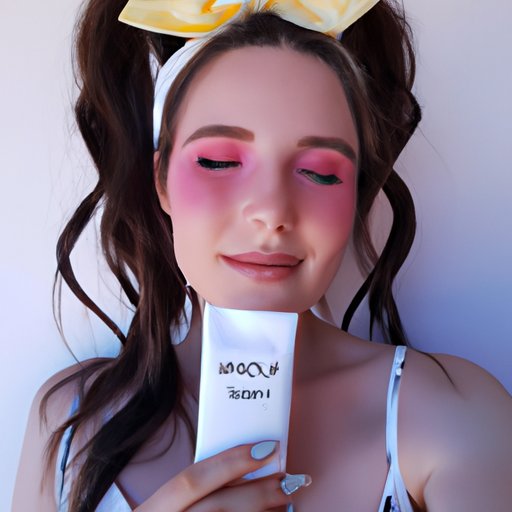Introduction
If you’re someone who has always wondered why you have a pale complexion, you’re not alone. Many individuals struggle with their skin color, especially when it comes to achieving a natural-looking glow. Having pale skin can be influenced by multiple factors, from genetics to lifestyle habits.
In this article, we’ll explore possible causes for pale complexion and provide solutions to address them. We’ll also discuss the science behind pale skin, debunk common myths, and offer advice on how to improve your skin tone through healthy habits. Furthermore, we’ll address the psychological effects of having a pale complexion and how to overcome insecurities. Lastly, we’ll give summer skin care tips for pale skin.
Our goal is to help you understand and address the issue of pale skin, so you can embrace your unique skin tone and achieve a natural-looking glow.
5 Possible Causes for Your Pale Complexion and How to Address Them
One of the main causes of a pale complexion is genetics. People with fair skin tend to produce less melanin, which gives color to the skin, hair, and eyes. Another common cause of pale skin is anemia, which is a condition that occurs when your body doesn’t have enough red blood cells. Low blood pressure can also contribute to a pale complexion as it reduces blood flow through the skin. Thyroid problems can impact the body’s metabolism, leading to pale skin. Lastly, lack of sun exposure can cause skin to become lighter or paler.
To address these causes, incorporating a balanced diet that’s high in vitamins and minerals can help. Foods like spinach, red meat, fish, beans, and nuts can boost iron levels and increase blood flow. Supplements like iron and vitamin D can also be helpful. Exposure to sunlight can contribute to higher melanin production, leading to natural tanning. However, it’s essential to use sunscreen to protect skin from damage. Medical advice should be sought for thyroid problems and other medical issues.
Understanding the Science Behind Why Some People are Naturally Pale
Skin color is primarily determined by genetics. Genes dictate how much melanin is produced by the melanocytes in our skin. People with fair skin tend to have fewer melanocytes and less melanin production. Various skin tones depend on the amount and type of melanin produced.
Being naturally pale does not signify poor health or unattractiveness. Historically, skin color and tone have been used to discriminate, but people of all skin tones can be healthy and beautiful. The idea that pale skin is less desirable is a mere social construct and should be challenged.
The Impact of Lifestyle on Skin Color: Could Your Habits be Making You Look More Pale?
Lifestyle habits like smoking, lack of exercise, poor diet, and alcohol intake can also impact skin color. These unhealthy habits can restrict blood flow to the skin’s surface, leading to a pale complexion.
Maintaining a healthy diet that includes plenty of fruits and vegetables helps supply the skin with essential nutrients and supports blood flow. Regular exercise enhances blood and oxygen flow, nourishing the skin and giving it a healthy glow. Avoiding smoking and alcohol can also help regulate blood flow, improving skin color.
The Psychological Effects of Being Pale: Overcoming Insecurities and Embracing Your Unique Skin Tone
Having a pale complexion can lead to insecurities and self-esteem issues, particularly in societies that admire tanned skin. One way to overcome these insecurities is by embracing your natural skin tone. A positive outlook on life and self-love can help build confidence and improve psychological health.
It’s important to recognize societal influences that link beauty with skin tone and challenge them. Every skin tone is unique and should be cherished. Social media advocacy groups and other resources can also offer psychological support to those struggling with skin tone-related issues.
Summer Skin Care Tips for Pale Skin: Embracing the Sun Safely and Achieving a Healthy Glow
Summer is a great time to enjoy the outdoors and soak up some vitamin D. However, for pale-skinned individuals, it’s essential to take note of the potential risks associated with too much sun exposure. Overexposure can lead to sunburn, premature skin aging, and skin cancer. It’s crucial to wear appropriate protective clothing such as wide-brimmed hats, sunglasses, and long-sleeved shirts during peak hours of sun exposure. A natural sunscreen with an SPF of at least 30 should be applied 30 minutes before going outside and reapplied every two hours.
Sunless tanning agents such as self-tanners or tinted moisturizers can help achieve a healthy and natural-looking glow without damaging the skin. Staying hydrated by drinking plenty of fluids is also an important summer skin care tip for maintaining a healthy skin glow.
Conclusion
To conclude, pale skin is not a sign of sickness or unattractiveness, and every skin color deserves appreciation. Various factors affect skin color and tone, from genetics to lifestyle choices. A healthy diet, regular exercise, and the application of sunscreen are all useful in maintaining healthy skin.
Embracing your unique skin tone and appreciating it can improve confidence and self-esteem. So, go out and celebrate your skin tone! Stay safe, stay healthy, and stay beautiful.
